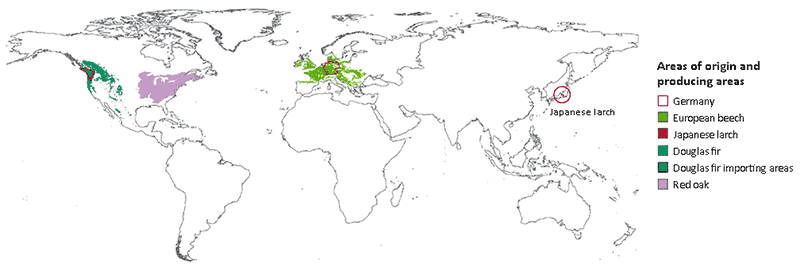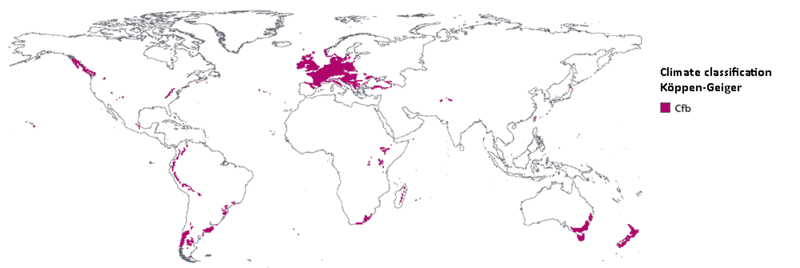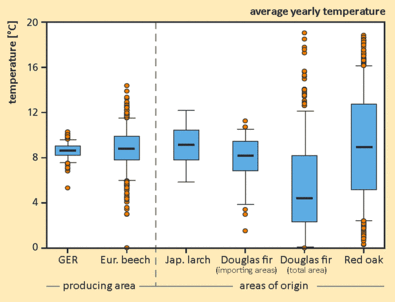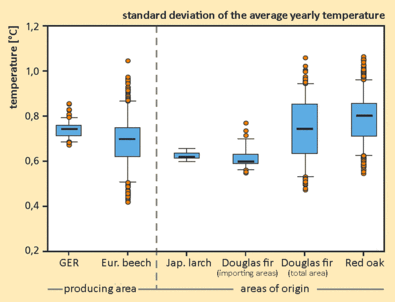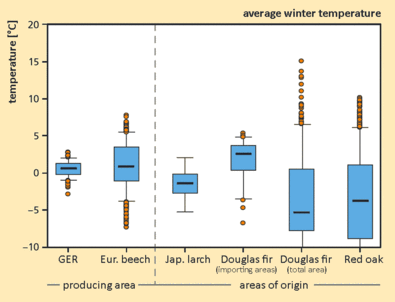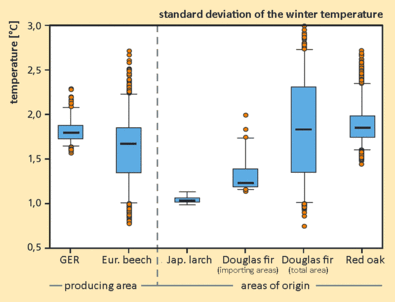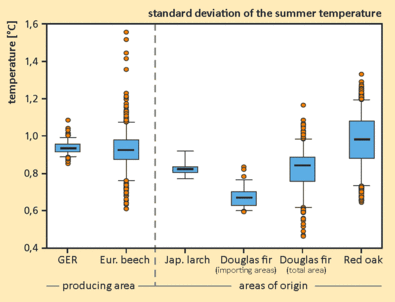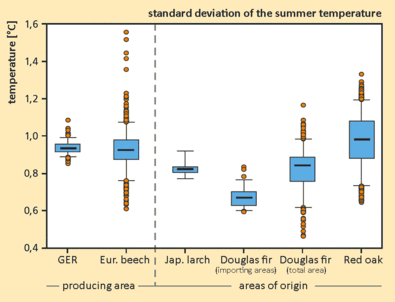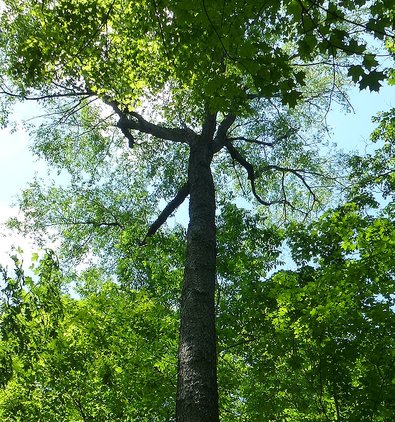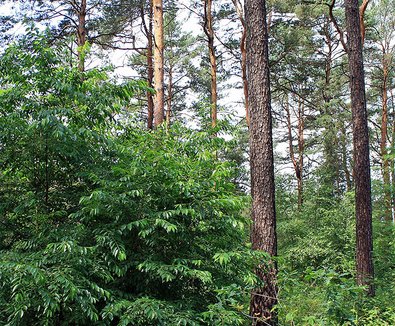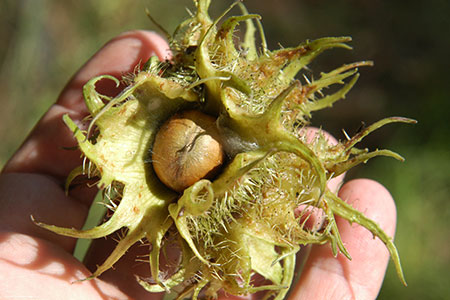Trees are more susceptible to the negative consequences of climate change when they are planted on the edge of their warm/dry ecological niche. As a last resort, this can countered with a change in species (e.g. from spruce to beech). The switch in tree species utilized and the conversion of the species composition in forest stands in Bavaria is a common practice in order to adapt the forest to the coming changes from a warming climate. This conversion will be incurred at a considerable cost.
The spectrum of eligible central European tree species that are appropriate for this conversion is limited to less than three dozen species. Many of them have a low economic value due to their rareness and are primarily deciduous trees. Presently, conifers dominate the forest in central Europe, which is in contrast to the potential natural vegetation. Clearly, the timber industry in central Europe is specialized on conifers. As a result, the forestry sector does not want to limit itself to central European broad-leaved species in its adaptation to climate change and considers conifers from other regions of the world.
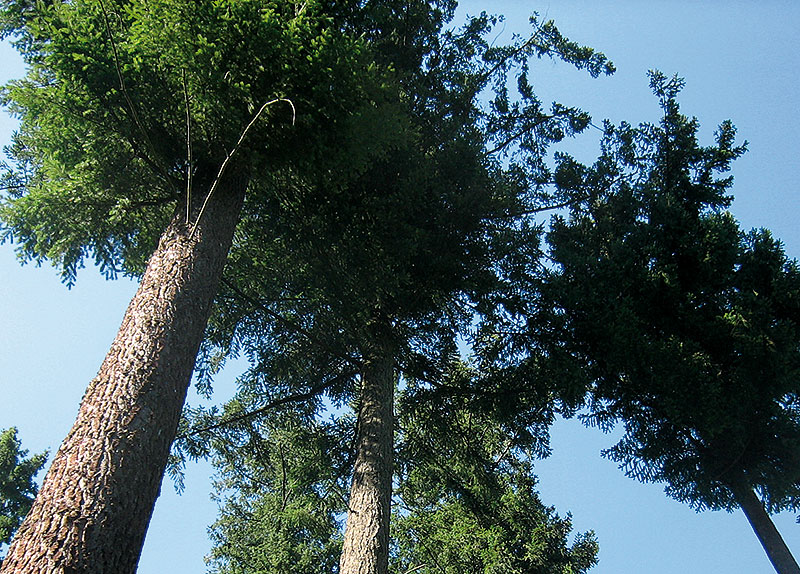
Fig. 1: Douglas fir is the most commonly cultivated non-native conifer in Germany (Picture: M. Mößnang).
Experiences with non-native tree species is limited
In comparison to the life of a tree, the practice of planting non-native tree species has not been around for a long time. In most cases, the length of the experiences is not more than 150 years and not longer than two rotations.
The interest for alternatives to be used in forest conversion has grown immensely with the change in climate. Naturally the desire for higher yields in growth, accompanied by a good suitability to a warmer and dryer climate, also play an important role. A search for alternate species in order to transform the forest to better face climate change has been underway for a long time. It is now imperative to examine the alternatives based on clear principles, in an emotionless manner and without stereotypes.
| Table 1: Areas of origin and frequency of cultivation for the most important non-native tree species in Germany (Source: BMELV 2013) | ||
| Tree species | Area of origin | Percent composition in the forested areas in Germany |
| Douglas fir (Pseudotsuga menziesii) | Northwest North America | 1,7 % |
| Japanese larch + hybrids (Larix kaempferi) | Japan | 0,7 % |
| Red oak (Quercus rubra) | Eastern North America | 0,4 % |
| Black locust (Robinia pseudoacacia) | Eastern North America | 0,3 % |
| Eastern white pine (Pinus strobus) | Eastern North America | < 0,19 % |
| Austrian/black pine (Pinus nigra) | (Central Europe), southern Europe | 0,13 % |
| Grand fir (Abies grandis) | Northwestern North America | < 0,09 % |
| Sweet chestnut (Castanea sativa) | Southern Europe | 0,07 % |
In the past, the forestry sector in Germany has almost exclusively cultivated non-European tree species from points originating in the Pacific Northwest of North America, eastern North America and from the Japanese islands of Honshu (Table 1 and Figure 2). The success of cultivation depends on various factors and should definitely not be taken for granted. The general risk of cultivating non-native tree species will not become less with the new, and more importantly, strong variations in climate.
The prerequisite is a similarity in climate
The prerequisite for the cultivation of non-native tree species is a strong similarity of the climate in its native range. Accordingly, a comparison of the climatic conditions between the areas of origin and cultivation for non-native species has to be undertaken as a first step.
An overview of the worldwide distribution of the climate type Cfb, the predominate climate type in Europe, shows that this warm to moderately humid climate with warm summers is only found in a few locations outside Europe (Figure 3). The requirement for similarity can only be partially fulfilled. Additionally, the classification is based solely on the present conditions and will not remain constant during climate change.
More promising is the utilization of climate parameters. Through a comparison of dominant average temperatures and their corresponding standard deviations (Figure 4) a similarity between areas of origin and cultivation can be estimated. We use the typical areas of origin for Douglas fir, Red oak and Japanese larch (Figure 2). The area of cultivation spans the extent of Germany and the range of European beech typically covers all of central Europe.
A comparison between areas of origin and cultivation
The average yearly temperatures in the areas to be compared differ only slightly (Figure 4.1). In this regard, it seems that the similarity prerequisite has been fulfilled. Solely Douglas fir exhibits considerably lower average yearly temperatures in its entire range. More can be revealed if seasonal temperatures are considered.
In the winter months from December till February, the temperatures in the ranges of the Japanese larch, Douglas fir and red oak vary from those in the areas of cultivation (Figure 4.3) and the winters in the areas of origin are much harsher than in Germany. In contrast, the area from where coast Douglas fir is imported has warmer winter temperatures than the areas of cultivation in central Europe.
Another view arises with a glimpse at the summer temperatures (Figure 4.5). From July to August the Japanese larch and red oak endure higher temperatures as in the areas of cultivation. In the areas from where Douglas fir is imported (and its whole native range for that matter) the summer temperatures are predominately lower than in the areas of cultivation in central Europe.
Additionally, if the standard deviations in figure 4.2, 4.4 and 4.6 are taken into consideration, particularly lower values for temperature can be seen in the areas from where coast Douglas fir is imported. The yearly, winter, and summer values exhibit a well-balanced oceanic climate. Also, there is little variation in winter temperatures throughout the range of Japanese larch. Similar temperature variations as in central Europe prevail in the native range of red oak. This makes it clear that there are limitations when comparing climate similarities with simple climate parameters. Failures in cultivation can be traced back to a lack of conformance between the climate in the area of origin and the area of cultivation.
Climate in central Europe: stress through variability
There are not too many places on earth with a climate similar to that of central Europe. Strong variations in temperature in, and between years, present a huge challenge for native species here as well. Through centuries of selection, central European tree species have become well adapted to these conditions whereas non-native tree species from other areas are not equipped with this adaptation.
The superiority in growth from a few non-native species is probably due to the transfer of resources. Instead of investing in protective mechanisms against a highly variable climate, resources are invested in growth, since similar effects can also arise through an unnecessary defense against parasites.
This can prove disastrous later on in the cultivation when pathogens unexpectedly emerge. Similar problems can arise when rare climatic stress situations occur and overwhelm the ill-adapted population. Most likely a reduction in growth is a fair trade for an increase in adaptability, stress tolerance and parasitic defense mechanisms.
Climate change as a catalyst for problems
It will become more difficult to substantiate the similarities in climate between the areas of origin and cultivation due to climate change. To plan appropriately, it will be necessary to compare similarities between two current day climate types and a future climate type. In the area of cultivation, the tree species should be adapted to both a cool climate in the present and a warmer climate in the future. This results in a reduction in the number of promising species for cultivation. Guidelines for cultivation that have been based on regional experience could loose their validity from climate change. The uncertainties will grow and it will become increasingly difficult to find appropriate species.
Beside the behavior in temperature, precipitation regimes also have to be taken into consideration. The trees do not directly take up precipitation by themselves but use the soil instead. Therefore, soil characteristics such as soil water capacity also have to be incorporated into any prognosis. The soil chemical characteristics also have to be suitable to ensure that balanced tree nutrition can be guaranteed.
Previous experiences
Except for Douglas fir (1,7% of the forest area) the cultivation of non-native tree species in Germany plays a minor role (Table 1). This is also true for neighboring countries. Examples of failures include the totally unsuccessful eastern white pine cultivation or the introduction of black cherry (Prunus serotina), which has developed into a noxious weed (Figure 6).
Our experiences with the cultivation from non-native tree species are often piecemeal, not impartial and rarely universal in nature. Trees that have been planted in parks and gardens can only deliver limited insights for cultivation in the forestry sector. Previously gained experiences are limited in their validity due to the new climate in the future. If the marginal conditions change, then our experiences will also loose their value.
Risks and side effects
Decisive for success is the intended main effect. Economic motives clearly stand in the forefront with regard to the cultivation of non-native tree species. Non-natives should only be cultivated when the financial yield exceeds that of natives and the risk of cultivation from the landowner is kept within reasonable limits.
Unintended side effects should additionally be kept in mind, especially with regard to the problem of invasiveness. What begins as cultivation can, under the right conditions, end in an unwanted "naturalization". Considerations for nature conservation or the suppression of native species are not the only characteristics used to judge invasiveness. Undesired consequences can also arise from invasive plants in forestry.
Criteria used for the decision to cultivate non-natives
The decision for the cultivation of non-native tree species is a demanding endeavor. Before one becomes determined to plant these trees, some questions have to be cleared up first:
- Economical value: Volume and biomass production, applicability, marketability, cost and yield
- Risk of cultivation: Similarity between the current and future climate, soil conditions and forest protection situation
- Seeds and sources
- Side effects: Invasiveness, influence on protected natural resources, silvicultural compatibility
For many of these questions we only have incomplete answers at the present time. In particular, the suitability for cultivation with regard to climate change is only rudimentarily answered.
Actually, the introduction of a new system of tests and field trial phases should be conducted before non-natives are utilized on a large scale. The typically long time periods necessary for forestry field trials could prove to be a problem due to the quickly accelerating change in climate. What’s more, field trials take place under current conditions and these vary from those expected in the future and during the test phase. Strictly speaking, the tests have to take place in distant regions in which the possible future climate already prevails.
The extent of the cultivation should be restricted on sites where doubt regarding risks, side effects and the success of cultivation exists. The mixture of native species into the cultivation should always be considered as a matter of principle.
Opportunities and new ventures
In order to expand the tree species palate in times of climate change, the cultivation of non-native tree species seems like an attractive alternative at first glance. Risks and side effects should be kept in mind. Very good arguments exist which favor the usage of appropriate native tree species. Non-native tree species have their justification on sites where natives are not a viable alternative. No matter what the case may be, the natural limitations for the cultivation of alternative tree species have to be clearly defined and secured through scientific observations and experiments.

